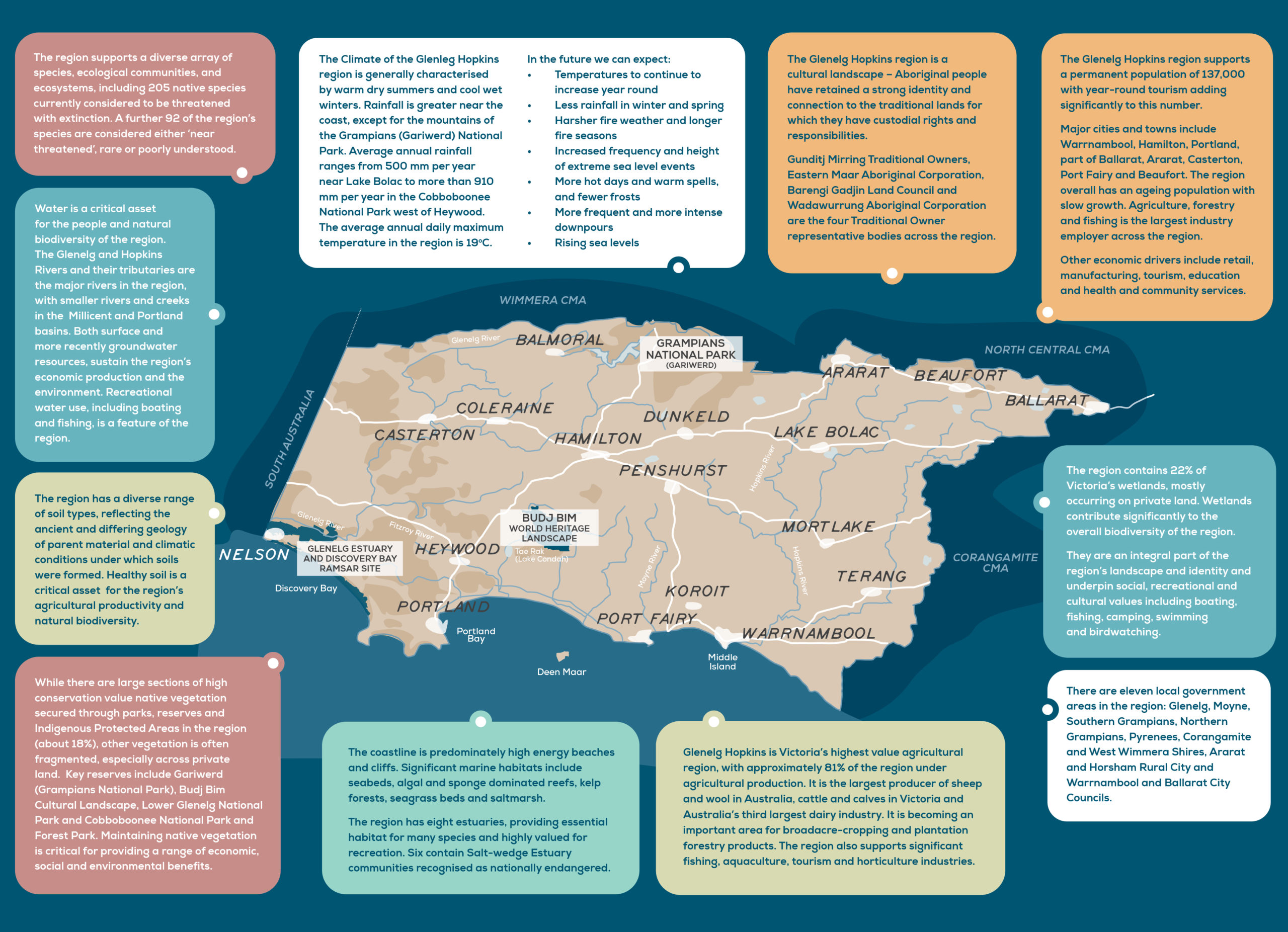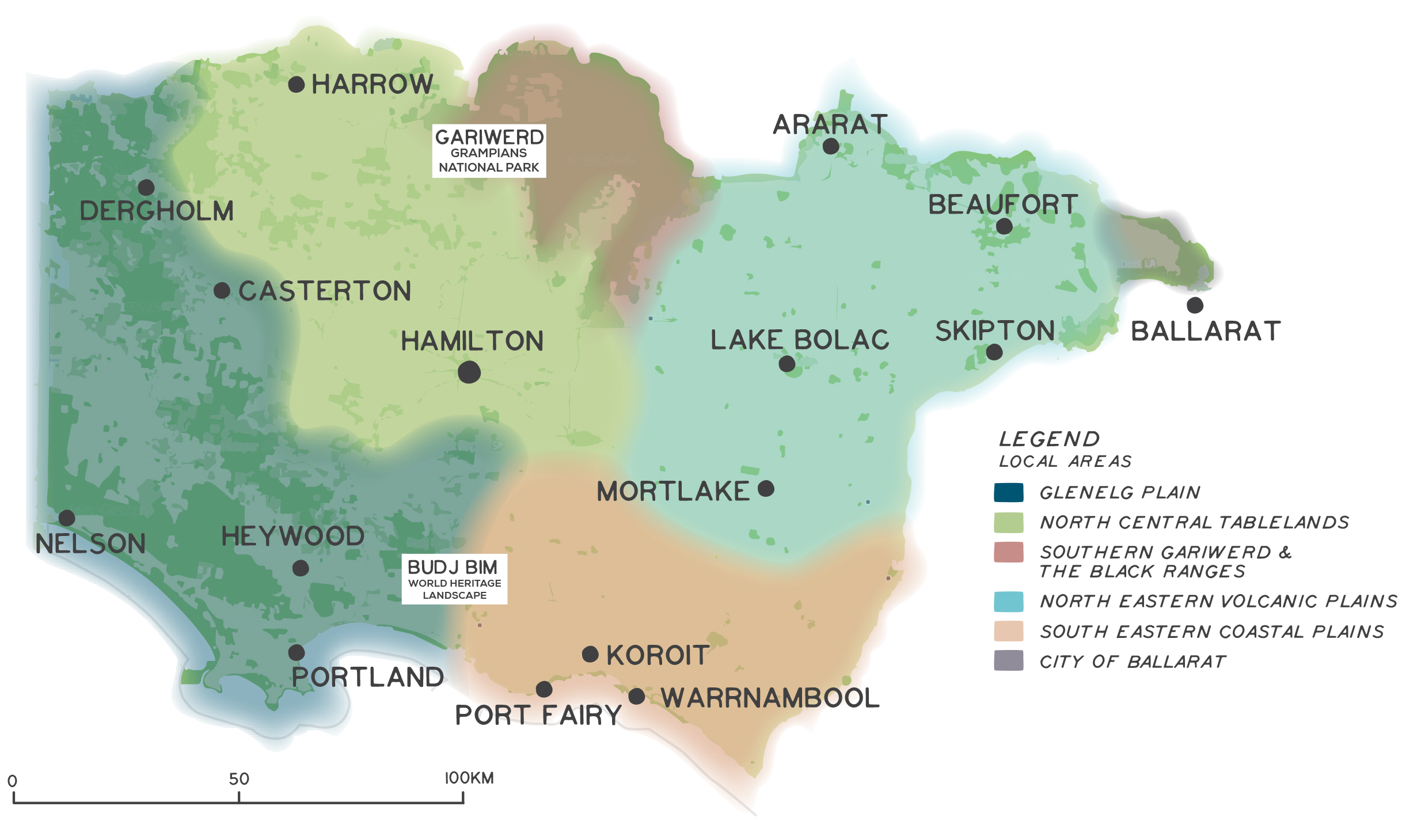RCS snapshot
Our plan for land, water and biodiversity
The Glenelg Hopkins Regional Catchment Strategy (RCS) is the overarching plan for integrated catchment management – how land, water and biodiversity is managed by the Glenelg Hopkins community. The RCS outlines the vision for the region, describes the current condition and trends of the catchment’s natural resources, and details priority directions, challenges and opportunities.
This page gives you a summary of the RCS.
More detail can be found by clicking on the links in each of the sections below.
Our region
The Glenelg Hopkins region lies south of the Great Dividing Range in Victoria’s south-west. It is a varied and productive region renowned for its agricultural industry, rich cultural heritage, scenic beauty, dramatic coastline and unique biodiversity.

2050 Vision
Empowered communities nurturing a rich and connected landscape for all – today, tomorrow, together
Local areas
The community in action
Local areas have been developed with community to capture key priorities and interests, as well as reflect the region’s social and biophysical systems. They bring together the RCS themes of Traditional Owners, community, water, biodiversity, land and marine and coast.

Glenelg Plains
Where the river meets the sea
Vision: A rich, connected and sustainably managed landscape of River, Forest, Sea and Stone Country from the northern Glenelg River to the coastal dunes of Discovery Bay
North Central Tablelands
A place of rolling hills and red gums
Vision: A thriving landscape, where production complements the grasslands and red gum woodlands between the upper Glenelg and Wannon Rivers
Southern Gariwerd & the Black Range
Symbolic, spiritual, healing
Vision: A living, cultural landscape cared for by Traditional Owners and the community to protect its values, heal and build resilience
North Eastern Volcanic Plains
Sweeping hills and windswept plains
Vision: A working landscape of diversity and production from the foothills of the Grampians across the grasslands and wetlands of the northern volcanic plains
South Eastern Coastal Plains
From grassland plains to the wild coast
Vision: Connecting communities to protect, restore and enjoy the natural environment across the southern volcanic plains to the shipwreck coast, while balancing the productivity of the land
City of Ballarat
Green, vibrant, connected
Vision: To ensure health and sustainability for Ballarat’s landscapes and community
RCS themes
Building blocks for a healthy and resilient landscape
RCS themes outline current condition and trends, major threats and drivers of change, desired outcomes for the future and priority management directions.
RCS outcomes
What success looks like
The Glenelg Hopkins RCS identifies desired outcomes for the future and priority management directions to achieve those outcomes. They include long-term outcomes to be achieved in 20+ years, as well as medium-term outcomes to be achieved in the six-year life of the strategy. Outcomes have been set for each of the RCS subthemes.
Community
By 2042, integrated catchment management (ICM) supports Traditional Owner self-determination
By 2027:
- Traditional Owner rights, interests, obligations and access to Country and water, including cultural flows, are acknowledged and protected.
- Traditional Owner groups are decision makers and provide strategic leadership in ICM.
- The social wellbeing of Traditional Owner communities has increased as a result of involvement in ICM.
- The economic benefit for Traditional Owner communities has increased as a result of involvement in ICM.
- There is an increased connection of agencies, authorities and community groups with Traditional Owner communities to build awareness and understanding of cultural landscapes management.
By 2042, the number of people connected to and involved in integrated catchment management has increased
By 2027:
- The regional community is informed and has capacity to adapt to, and mitigate, the impacts of climate change.
- The regional community is more engaged and empowered to participate and partner in integrated catchment management.
- The regional community recognises that the social, cultural and economic benefits of people connecting with nature depends on a healthy environment.*
*Outcome is linked to the Biodiversity 2037 goal that ‘Victorians value nature’ and that Victorians understand that their personal wellbeing and the economic wellbeing of the state are dependent on the health of the natural environment.
Water
By 2042, Traditional Owner communities are decision makers and provide strategic leadership for River Country
By 2027:
- Traditional Owners rights, interests, obligations and access to water, including cultural flows, are acknowledged and protected.
- Traditional Owner communities have the capacity, knowledge and authority to look after river Country including cultural flows.
By 2042, the condition, function and resilience of priority rivers and their floodplains are maintained or improved
By 2027:
- The community has increased knowledge and capacity to collaborate on river and floodplain management.
- Habitats for key regional indicator species are managed to ensure that their regional population and distribution is at least maintained.
- Progress is made towards delivering on the interim water quality targets developed for the Glenelg Hopkins Regional Waterway Strategy.
- The management of river hydrology is improved.
- The condition and connectivity of rivers and riparian areas continues to increase, supporting the diversity of habitats associated with rivers and their floodplains.
By 2042, flood risks are reduced through improved flood intelligence and mitigation
By 2027:
- 80% of the Glenelg Hopkins Regional Floodplain Management Strategy priority management actions are implemented.
By 2042, the function and resilience of wetlands are maintained or improved
By 2027:
- Traditional Owner communities have the capacity, knowledge and authority to look after wetlands and their restoration including cultural flows.
- The community has increased knowledge and capacity to collaborate on wetland management.
- An increased number and diversity of wetlands are managed to restore function, mitigate threats and protect values.
- The number and extent of wetlands with improved or restored hydrology has increased.
By 2042, manage specific threats to estuaries and improve condition improved where possible
By 2027:
- Connectivity between the freshwater and estuarine systems supports ecosystem health and maintains the diversity of species.
- The natural processes that support the values of Salt Wedge estuaries are maintained.
- Regional communities recognise and value estuaries.
By 2042, the hydrological requirements of priority Groundwater Dependent Ecosystems (GDE) are protected
By 2027:
- Stakeholders are better informed about the hydrological needs of priority Groundwater Dependent Ecosystems (GDE) and the impacts of climate change and catchment activities, including landuse and the diversion of water, on groundwater.
- Changes in groundwater water balance are factored into resource allocation decisions and management.
By 2042, changes in groundwater water balance are factored into resource allocation decisions and management
By 2027:
- Any reviews of groundwater extraction and development controls include increased recognition of the needs of the regional environment, values associated with groundwater and future sustainability of the resource.
Biodiversity
By 2042, the extent of native vegetation will be maintained or increased
By 2027:
- The extent of revegetation has increased across the region, including at least 10,000 ha in priority locations for habitat connectivity.*
- The community has increased knowledge and capacity to support remnant vegetation protection.
*Outcome is linked to the statewide Biodiversity 2037 target, ‘200,000 hectares of revegetation in priority locations for habitat connectivity since 2017’. In the Glenelg Hopkins region the 2037 the target is ‘20,000 hectares of revegetation in priority locations for habitat connectivity since 2017’.
By 2042, the condition, function and resilience of native ecosystems will be maintained or improved
By 2027:
- Traditional Owner communities have the capacity, knowledge and authority to look after their understanding of native habitats, including culturally significant species and groundwater dependant systems.
- 7,500 ha of native vegetation will be permanently protected by inclusion in the protected areas network.*
- 72,000 ha under sustained weed control and 184,000 ha under sustained herbivore control in priority locations.#
- The ecological processes that underpin the function and resilience of native vegetation are better understood and built into restoration and conservation programs.
- The connectivity of habitat for species, populations and communities will be improved.
- The resilience and condition of protected areas and public land will be maintained or improved.
*Outcome is linked to the statewide Biodiversity 2037 target, ‘200,000 hectares permanently protected since 2017’. In the Glenelg Hopkins region the 2037 target is ‘15,000 hectares permanently protected since 2017’.
#Outcome is linked to the statewide Biodiversity 2037 targets, ‘1,500,000 hectares in priority locations under sustained weed control’ and ‘4,000,000 hectares in priority locations under sustained herbivore control’. In the Glenelg Hopkins region the 2037 targets are, ‘90,000 hectares in priority locations under sustained weed control’ and ‘230,000 hectares in priority locations under sustained herbivore control’.
By 2042, the health of key populations of threatened species and communities is maintained or improved
By 2027:
- Traditional Owner communities have the capacity, knowledge and authority to look after their understanding of threatened native species, including culturally significant species and groundwater dependant species and communities.
- 100,000 ha of priority locations are under sustained pest predator control.
- The trajectory of priority threatened species and ecological communities is stabilised or improved.
- Climate refuges for threatened species and ecological communities vulnerable to climate change are established and protected.
Land
By 2042, land managers are supported to manage land and water within its capability
By 2027:
- There is increased understanding and protection of Aboriginal cultural values and heritage across the landscape and throughout the community.
- 500 land managers have knowledge and awareness of land capability.
- 200 land managers are supported to manage their land to meet duty-of-care and legislative obligations.
- Land managers have increased understanding of sustainable water availability and land capability for irrigation.
- Irrigators are increasingly supported to improve water use efficiency and irrigation practices.
- Three forestry managers are supported to enhance integrated catchment management outcomes across plantation estate.
- Eight opportunities have been investigated for a range of market based instruments, policy, incentives, and market drivers, to support land managers to adopt improved land management practices and value on-farm biodiversity.
By 2042, there is an increase in the area of land managed for improved soil health
By 2027:
- 800 land managers have an awareness of and/or adoption of land management practices that improve and protect the condition of soil.
- 400 land managers have knowledge and awareness of soil health and the associated beneficial ecosystem services.
- Annual mean percentage groundcover is at, or above, 85% (less than 15% of ground exposed).
- 60 land managers are managing for improved soil carbon levels.
By 2042, there is an increase in the capacity of land managers and agriculture systems to adapt to significant changes in climate and market demands
By 2027:
- 1,800 land managers have the capacity to manage land for production and complementary biodiversity outcomes.
- Two regional post-secondary education and training providers are supported in filling skill gaps and workforce shortages in the agriculture industries.
- 100 land managers have the knowledge and capacity to adapt to and mitigate the impacts of climate change.
- 25 land managers are supported to make informed decisions about market access, diversification, value-added and niche market development.
- 100 land managers have increased capacity for adoption of innovative agricultural practices and technologies within sustainable farm management.
- Traditional Owners lead the regional development of the native food and botanical industry.
- A drainage management plan is developed for the Condah drainage scheme.
Marine and coast
By 2042, Traditional Owner communities are decision makers and provide strategic leadership for Sea Country
By 2027:
- Traditional Owners rights, interests, obligations and access to coastal environments and Sea Country, including water and cultural flows, are acknowledged and protected along the marine and coast environment.
- Traditional Owner communities have the capacity, knowledge and authority to look after Sea Country.
- There is increased understanding and protection of at risk Aboriginal cultural values and heritage sites along the coastline.
By 2042, manage specific threats to coastal systems and improve condition where possible
By 2027:
- The amount of nutrients and pollutants directly discharged into the coast and marine environment is reduced.
- There is improved understanding and management of threats to priority coast and marine species and ecological communities.
By 2042, improve the resilience and adaptive capacity of the marine and coastal environment and resources to the impacts of climate change and development
By 2027:
- Build climate resilience and adaptative capacity into planning approaches.
- Community and stakeholders have improved understanding of coastal processes and adaptation options.



